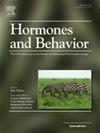Sex difference in the effects of ventral pallidum vasopressin 1a receptor partial knockdown on social behavior in mice
IF 2.4
3区 医学
Q2 BEHAVIORAL SCIENCES
引用次数: 0
Abstract
The neuropeptide vasopressin (AVP) regulates a diverse array of social behaviors, often having different functions in males and females. This sex difference is due, in part, to the AVP cells in the bed nucleus of the stria terminalis (BNST), which are more numerous in males than in females. These AVP cells send stronger projections to several brain regions that express the vasopressin 1a receptor (V1aR), including the ventral pallidum (vPal), an area broadly implicated in reward-seeking behavior. Previous experiments manipulating V1aR in vPal have found that activation of V1aR in this area mediates AVP effects on social behavior with differential effects on male and female rats across different social contexts. Consequently, to better understand the role of V1aR in vPal, we reduced V1aR expression in the vPal using a viral-mediated RNA-interference approach in male and female mice and tested their social investigatory, aggressive, copulatory and communicative responses to male and female conspecifics as well as their responses to anxiogenic or rewarding stimuli. Partial knockdown of V1aR in vPal of males reduced their social investigation of other males, but not of females, whereas the same manipulation had no effect on social investigation in females. In addition, partial knockdown in males reduced latencies to ejaculate during copulation. Reduction in V1aR within vPal did not influence communicative and aggressive behaviors, urine investigation, anxiety-like behavior, or sucrose preference. These results suggest that V1aR activity in the vPal specifically facilitates intermale investigation in adult mice but normally dampens their ejaculatory behavior.
小鼠腹侧白质抗利尿激素1a受体部分敲除对社会行为影响的性别差异
神经肽抗利尿激素(AVP)调节各种各样的社会行为,通常在男性和女性中具有不同的功能。这种性别差异部分是由于终纹床核(BNST)中的AVP细胞,雄性比雌性多。这些AVP细胞向几个表达抗利尿激素1a受体(V1aR)的大脑区域发送更强的投射,包括腹侧苍白球(vPal),这是一个广泛涉及寻求奖励行为的区域。先前操纵vPal区V1aR的实验发现,该区域V1aR的激活介导了AVP对社会行为的影响,在不同的社会背景下,雄性和雌性大鼠的影响有所不同。因此,为了更好地理解V1aR在vPal中的作用,我们使用病毒介导的rna干扰方法降低了雄性和雌性小鼠vPal中V1aR的表达,并测试了它们对雄性和雌性同种动物的社会调查、攻击、交配和交流反应,以及它们对焦虑或奖励刺激的反应。男性vPal中V1aR的部分下调会降低其对其他男性的社会调查,但对女性没有影响,而同样的操作对女性的社会调查没有影响。此外,雄性基因的部分敲除减少了交配过程中射精的潜伏期。vPal中V1aR的降低不影响交流和攻击行为、尿液调查、焦虑样行为或蔗糖偏好。这些结果表明,vPal中的V1aR活性特别促进了成年小鼠的雄性间调查,但通常会抑制它们的射精行为。
本文章由计算机程序翻译,如有差异,请以英文原文为准。
求助全文
约1分钟内获得全文
求助全文
来源期刊

Hormones and Behavior
医学-行为科学
CiteScore
6.70
自引率
8.60%
发文量
139
审稿时长
91 days
期刊介绍:
Hormones and Behavior publishes original research articles, reviews and special issues concerning hormone-brain-behavior relationships, broadly defined. The journal''s scope ranges from laboratory and field studies concerning neuroendocrine as well as endocrine mechanisms controlling the development or adult expression of behavior to studies concerning the environmental control and evolutionary significance of hormone-behavior relationships. The journal welcomes studies conducted on species ranging from invertebrates to mammals, including humans.
 求助内容:
求助内容: 应助结果提醒方式:
应助结果提醒方式:


